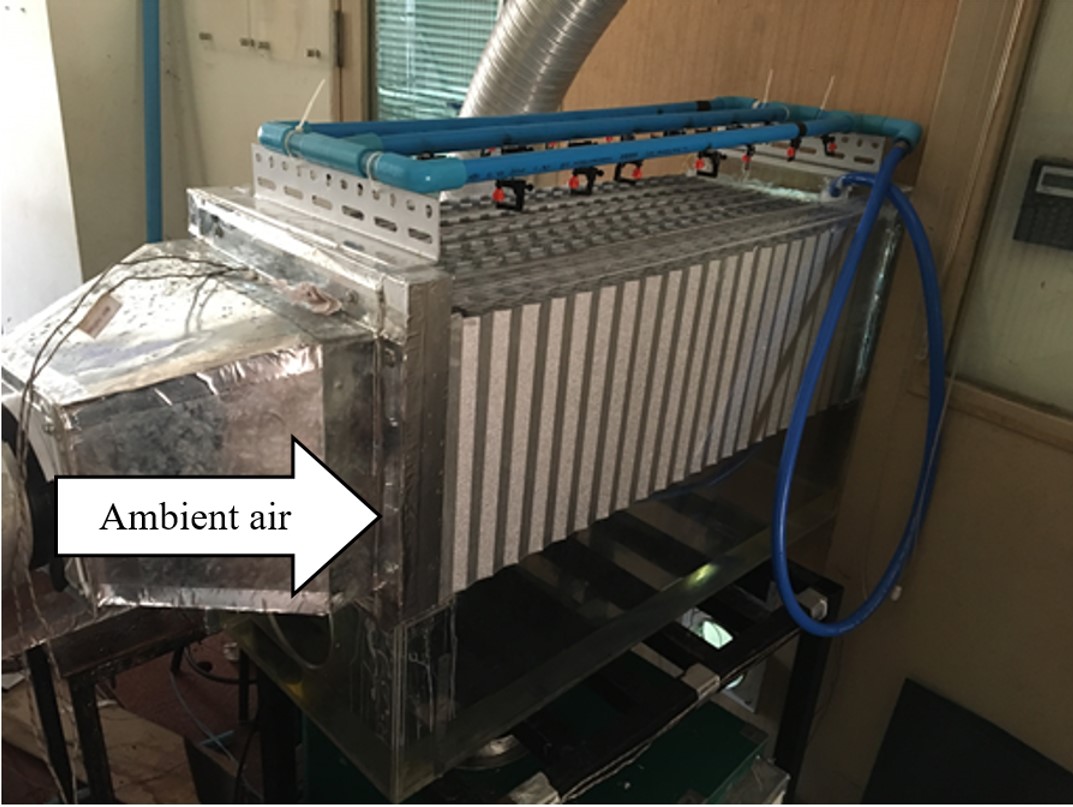Simulation of a hybrid dew-point evaporative cooling system
Main Article Content
Abstract
This article aims to investigate the factors influencing the performance of a hybrid dew-point evaporative cooling system (HDPEC) in a 7-Eleven store in Thailand. Those factors are the channel length, channel gap, air flow rate, and operational strategy of the system. The simulations were conducted using the TRNSYS program. The hybrid system consists of a dew-point evaporative cooler and a vapor-compression air-conditioning system (VAC). Three operational strategies were examined. The first is that both evaporative cooler and VAC operate 24 hours simultaneously. The second is that the cooler and VAC are on when the room temperature is higher than 25˚C and they are off when the room temperature is less than 23˚C. The third is that only the VAC operates and it is on when the room temperature is higher than 25˚C and is off when the room temperature is less than 23˚C. It was revealed that the second strategy consumes the least electricity compared to the others. In addition, the performances of HDPEC in the provinces of Bangkok, Nakhon Ratchasima, Sakon Nakhon, and Chiang Mai were compared. It was found that the annual power consumption of a 7-Eleven store with HDPEC in Bangkok is 39.62% less than that of the store with VAC alone. This is the largest reduction of power consumption among the provinces studied. The wet-bulb effectiveness and the payback period of the system in Bangkok are 1.37 and 3.5 months, respectively.
Article Details

This work is licensed under a Creative Commons Attribution-NonCommercial-ShareAlike 4.0 International License.
This work is licensed under a Creative Commons Attribution-NonCommercial-ShareAlike 4.0 International License.
References
Yungchareon, V. and Limmeechokchai, B. Energy analysis of the commercial sector in thailand: potential savings of selected options in commercial buildings, Sustainable Energy and Environment (SEE) 2004, Hua Hin, Thailand.
C.P. ALL public company limited. Convenient store in 2017, URL: http://www.cpall.co.th, accessed on 26/11/2019, 2017.
Yin, X., Wang, X., Li, S. and Cai, W. Energy-efficiency-oriented cascade control for vapor compression refrigeration cycle systems, Energy, Vol.116(1), 2016, pp. 1006-1019.
Al-Badri, A.R. and Al-Waaly, A.A.Y. The influence of chilled water on the performance of direct evaporative cooling, Energy Build, Vol. 155, 2017, pp. 143-150.
Bishoyi, D. and Sudhakar, K. Experimental performance of a direct evaporative cooler in composite climate of India, Energy Buildings, Vol. 153, 2017, pp. 190-200.
Sohani, A. and Sayyaadi, H. Design and retrofit optimization of the cellulose evaporative cooling pad systems at diverse climatic conditions, Applied Thermal Engineering, Vol. 123, 2017, pp. 1396-1418.
Kim, H.J., Ham, S.W., Yoon, D.S. and Jeong, J.W. Cooling performance measurement of two cross-flow indirect evaporative coolers in general and regenerative operation modes, Applied Energy, Vol. 195, 2017, pp. 268-277.
Riangvilaikul, B. and Kumar, S. An experimental study of a novel dew point evaporative cooling system, Energy Buildings, Vol. 42, 2010, pp. 637-644.
Duan, Z., Zhao, X. and Li, J. Design fabrication and performance evaluation of a compact regenerative evapora-tive cooler: Towards low energy cooling for buildings, Energy, Vol. 140, 2017, pp. 506-519.
Zhan, C., Duan, Z., Zhao, X., Smith, S., Jin, H. and Riffat, S. Comparative study of the performance of the M-cycle counter-flow and cross-flow heat exchangers for indirect evaporative cooling - Paving the path toward sustainable cooling of buildings, Energy, Vol. 36, 2011, pp. 6790-6805.
Xu, P., Ma, X., Diallo, T.M.O, Zhao, X., Fancey, K., Li, D., et al. Numerical investigation of the energy perfor-mance of a guideless irregular heat and mass exchanger with corrugated heat transfer surface for dew point cooling, Energy, Vol. 109, 2016, pp. 803-817.
Chauhan, S.S. and Rajput, S.P.S. Experimental analysis of an evaporative-vapour compression based combined air conditioning system for required comfort conditions, Applied Thermal Engineering, Vol. 115, 2017, pp. 326-336.
Delfani, S., Esmaeelian, J., Pasdarshahri, H. and Karami, M. Energy saving potential of an indirect evaporative cooler as a pre-cooling unit for mechanical cooling systems in Iran, Energy Buildings, Vol. 42, 2010, pp. 2169-2176.
Cui, X., Chua, K.J., Islam, M.R. and Ng, K.C. Performance evaluation of an indirect pre-cooling evaporative heat exchanger operating in hot and humid climate, Energy Conversion and Management, Vol. 102, 2015, pp. 140-150.
Coca-Ortegon, A., Prieto, J. and Coronas, A. Modelling and dynamic simulation of a hybrid liquid desiccant system regenerated with solar energy, Applied Thermal Engineering, Vol. 97, 2016, pp. 109-117.
Abdel-salam, A.H., Ge, G. and Simonson, C.J. Performance analysis of a membrane liquid desiccant air-conditioning system, Energy and Buildings, Vol. 62, 2013, pp. 559-569.
Chua, K.J., Xu, J., Cui, X., Ng, K.C. and Islam, M.R. Numerical heat and mass transfer analysis of a cross-flow indirect evaporative cooler with plates and flat tubes, Heat Mass Transfer, Vol. 52, 2016, pp. 1765-1777.
Gaddis, E. and Gnielinski, V. Pressure drop in cross flow across tube bundles, International Journal of Chemical Engineering (United States), Vol. 25, 1985, pp. 1-15.
Moshari, S. and Heidarinejad, G. Analytical estimation of pressure drop in indirect evaporative coolers for power reduction, Energy Build, Vol. 150, 2017, pp. 149-162.
Chen, Y., Luo, Y. and Yang, H. A simplified analytical model for indirect evaporative cooling considering condensation from fresh air: Development and application, Energy Buildings, Vol. 108, 2015, pp. 387-400.



